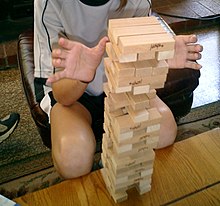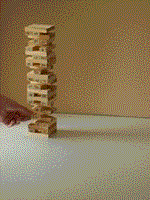Jenga
 | |
| Players | 1 or more |
|---|---|
| Setup time | < 2 minutes |
| Playing time | Usually 5-15 min |
| Chance | None |
| Age range | 6 and up |
| Skills | Manual dexterity |
Jenga is a game of physical and mental skill created by Leslie Scott, and currently marketed by Parker Brothers, a division of Hasbro. During the game, players take turns to remove a block from a tower and balance it on top, creating a taller and increasingly unstable structure as the game progresses.
The word jenga is the imperative form of kujenga, the Swahili verb "to build".
Rules
Jenga is played with 54 wooden blocks. Each block is three times as long as it is wide, and one fifth as thick as it is long (1.5 x 2.5 x 7.5 cm). To set up the game, the included loading tray is used to stack the initial tower which has 18 levels of three blocks placed adjacent to each other along their long side and perpendicular to the previous level (so, for example, if the blocks in the first level lie lengthwise north-south, the second level blocks will lie east-west).
Once the tower is built, the person who built the tower moves first. Moving in Jenga consists of taking one and only one block from any level (except the one below the incomplete top level) of the tower, and placing it on the topmost level in order to complete it. Only one hand at a time may be used to remove a block; either hand can be used, but only one hand may be in contact with the tower at a time. Blocks may be bumped to find a loose block that will not disturb the rest of the tower. Any block that is moved out of place may be left out of place if it is determined that it will knock the tower over if it is removed. The turn ends when the next person to move touches the tower or after ten seconds, whichever occurs first.
The game ends when the tower falls in even a minor way—in other words, any piece falls from the tower, other than the piece being knocked out to move to the top. The loser is the person who made the tower fall (i.e., whose turn it was when the tower fell). However, if one or more blocks fall but all players agree that they can be put back on the tower for play to resume, that is in keeping with the cooperative aspect of the game.
Origins
Jenga was created by Leslie Scott,[1] the co-founder of Oxford Games Ltd, based on a game that evolved within her family in the early 1970s using children's wood building blocks[2] the family purchased from a sawmill in Takoradi, Ghana. Though a British national, Scott was born in East Africa, where she was raised speaking English and Swahili, before moving to live in Ghana, West Africa. Scott launched the game she named and trademarked as 'Jenga' at the London Toy Fair in January 1983[3] and sold it through her own company, Leslie Scott Associates. The blocks of the first sets of Jenga were manufactured for Scott by the Camphill Village Trust in Botton, Yorkshire. The V&A Museum of Childhood has exhibited one of the original sets of Jenga since 1982.[4]

In 1984, Robert Grebler, an entrepreneur from California who was the brother of a close friend of Scott, contacted her and expressed interest in importing and distributing Jenga in Canada. In April 1985, Grebler acquired from Scott the exclusive rights to Jenga for the U.S. and Canada, and then in October that year, Scott assigned the worldwide rights in Jenga to Grebler,[5] which he in turn assigned to Pokonobe Associates. Convinced of Jenga's potential, Grebler had invited two first cousins, David Grebler and Paul Eveloff, to form Pokonobe Associates with him in 1985 to increase distribution of Jenga.[6] Under the astute guidance of Leonard Messinger, a Los Angeles intellectual property lawyer, and having acquired the rights to Jenga, Pokonobe then licensed Irwin Toy to sell Jenga in Canada and to be master licensees worldwide. Irwin Toy licensed Jenga to Schaper in the U.S. and when that company was bought by Hasbro, Jenga was launched under the Milton Bradley banner.[7] Eventually, Hasbro became licensee in most countries around the world.
Today, according to Leslie Scott, over 50 million Jenga games, equivalent to more than 2.7 billion Jenga blocks, have been sold worldwide.[3]
Tallest tower
Robert Grebler, probably because he spent so much time demonstrating Jenga in its early years, may have built the tallest Jenga tower ever at 40 2/3 levels. Grebler built that tower in 1985 while playing with an original Jenga set produced by Leslie Scott in the early 1980s.[8][dubious – discuss] kimi was the world's jenga champion... Until Hollie defeated her, beating her tower by an amazing ten meters, causing Kimi to have a nervous breakdown and cry for what seemed like ETERNITY!!
Official Hasbro variants
Throw 'n Go Jenga is a variant marketed by Hasbro. It consists of blocks that are colored red, blue, or yellow plus a six-sided die. Before each move, the player throws the die and then follows the instructions on the die:
- Yellow/End: Remove any yellow block or remove any color end block.
- Red/Mid: Remove any red block or remove any color middle block.
- Blue/End: Remove any blue block or remove any color end block.
- Any two: Remove any two blocks of any color in any position.
- Wild: Remove any color block in any position
- Reverse: Do not remove any blocks, but pass the die to the next player in the opposite direction.
Other than the fact that the die determines the proper move, play continues the same as regular Jenga.

Jenga Truth or Dare is an adult variation of Jenga also marketed by Hasbro. This version looks like regular Jenga except there are three colors of blocks, red, green and natural, instead of just the natural color of Jenga. Play is the same, but if a player moves a red block on his/her play, he/she has to complete the dare printed on it before stacking the block on top. If he/she moves a green block, he/she has to truthfully answer the question printed on the block before stacking it. The natural blocks have nothing printed on them and are played as in Jenga. However, it is permissible to write a player's own truths or dares on the natural blocks if desired.
Jenga Xtreme uses parallelogram-shaped blocks that can create some interesting leaning towers.
Casino Jenga: Las Vegas Edition employs a roulette-style game play, featuring a felt game board, betting chips, and additional rules.
In addition, there have been a number of collector edition Jenga games, featuring the colors and logos of the Boston Red Sox, Oakland Raiders, New York Yankees, and John Deere, among others. Hello Kitty Jenga, Transformers Jenga, Tarzan Jenga, Tim Burton's The Nightmare before Christmas Jenga, and Donkey Kong Jenga are some of the licensed variations of Jenga.
Video games
Jenga World Tour for Nintendo Wii and DS was released by Atari on December 7, 2007. A new version of the Jenga game for the Nintendo Wii is available from Electronic Arts as part of Hasbro's Family Game Night 2 offering.
An iOS version exists, released in late 2010 by NaturalMotion. There is also a version for Android phones.
Mathematical analysis
Uri Zwick has analyzed the game using techniques of combinatorial game theory, under the assumption that players have perfectly steady hands and so the game only ends when a player is forced to collapse the tower through lack of any remaining move which would leave it in a stable state. In a two-player game starting with a tower of n ≥ 4 layers, the first player can win if and only if n is not divisible by 3.[9]
Notes
- ^ Amazing Origins of Timeless Toys, 244
- ^ "Strong National Museum of Play". Strongmuseum.org. 2009-01-20. Retrieved 2010-05-19.
- ^ a b About Jenga: The Remarkable Business of Creating a Game that Became a Household Name. Leslie Scott (Greenleaf Book Group Press)[1]
- ^ http://www.vam.ac.uk/things-to-do/blogs/british-toy-making-blog/personal-view-leslie-scott-inventor-jenga
- ^ About Jenga, 108
- ^ Amazing Origins of Timeless Toys, 247
- ^ Amazing Origins of Timeless Toys, 248
- ^ Marketing copy on inside lid of Vintage Game Collection edition of Jenga marketed by Parker Brothers and currently on sale
- ^ Zwick, U. 2002. Jenga. In Proceedings of the Thirteenth Annual ACM-SIAM Symposium on Discrete Algorithms (San Francisco, California, January 06 - 08, 2002). Symposium on Discrete Algorithms. Society for Industrial and Applied Mathematics, Philadelphia, PA, 243-246.
References
- Walsh, Tim (2004). The Playmakers: Amazing Origins of Timeless Toys. Keys Publishing.

